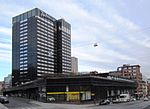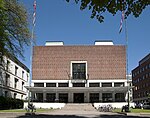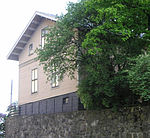Oslo and Akershus University College
Oslo and Akershus University College (Norwegian: Høgskolen i Oslo og Akershus, abbr. HiOA) was the largest state university college in Norway from its establishment in 2011 until 2018, when it was transformed into Oslo Metropolitan University, the youngest of Norway's new universities. It had more than 20,000 students and 2,100 employees. HiOA had higher education programs at bachelor's, master's and PhD level. It offered studies and conducted research in health professions, social sciences, engineering, liberal arts, and other fields. HiOA was established in 2011 following the merger of Oslo University College and Akershus University College, which were themselves the results of many previous mergers. In 2014 the Work Research Institute and Norwegian Social Research were also merged into the institution, and from 2016 it also incorporates the Norwegian Institute for Urban and Regional Research and the National Institute for Consumer Research. Most of the university college was located in the city centre of Oslo along the Pilestredet street, with subsidiary campuses in Sandvika and Kjeller in Akershus.
Excerpt from the Wikipedia article Oslo and Akershus University College (License: CC BY-SA 3.0, Authors).Oslo and Akershus University College
Dalsbergstien, Oslo St. Hanshaugen
Geographical coordinates (GPS) Address Website Nearby Places Show on map
Geographical coordinates (GPS)
| Latitude | Longitude |
|---|---|
| N 59.921869444444 ° | E 10.733405555556 ° |
Address
OsloMet – storbyuniversitetet (Oslo Metropolitan University)
Dalsbergstien
0170 Oslo, St. Hanshaugen
Norway
Open on Google Maps









